________________
70
The Jaina Stupa at Mathura: Art & Icons
"The wall of the city was constructed of hard stone, and two gates opened upon the river flowing under the city, which were erected upon strong and lofty foundations, to protect them against the floods of the river and rains. On both sides of the city, there were a thousand houses, to which idol temples were attached, all strengthened from top to bottom by rivets of iron, and all made of masonry work".85
Al-Utbi was a secretary of Ghazani. He mentioned all the information. regarding his campaigns in "Tarikhe-yamini". Gazani sacked Mathurā in his ninth invasion. The date of invasion advancing towards Mathurā and surrounding area is given as 20th of Rajab, 409 H. (Hizari Samvat) i.e. 2nd December 1018 A.D. This is the first reliable record of an attack on the ancient glory of Mathura and its neighbouring area. He entered India with his ten thousand soldiers. The king who held the passes leading to Kaśmira accepted his sovereignty and guided Sultan. and his army to the dense forests. The army travelled day and night until they crossed Jamuna river on about given date. The described places are identified by Firista, Jarbadkani and other Historians86. The place Barana is identified as Bulanda çity. In the view of Dr. Sagarmal Jain, the place Barana is Värnavata or Bäranavat where Pandavas were planned to burn in Läkṣagriha by Kauravas; here the Vāraṇa gana was introduced as Jaina ascetic order by Acaryas. The fort of Kulchanda having vast territory, enormous wealth and deep forests is recognized. as Mahābana near Mathură.
He first took over Barana/Barba, then marched towards Kulchand's fort. The king of the fort was very brave and fought with the Sultan in deep forest. When all attempts failed, the king and his army tried to cross the Jamuna river, but they were all either killed or drowned. The king Kulchanda first slew his wife with dagger, and then killed himself. The Sultan received enormous wealth, 185 elephants and other booty by this victory. After winning this battle, he and his army rushed towards a place called Maharātu, which was later recognized as Mathura. The author of the Vividha-tirtha-kalpa had described the city as Mahurǎura.87 "He noticed one huge building from the outskirts of
85 Elliot and Dowson, History of India as told by its own Historians, Vol. II, pp-44-5. 86 Elliot and Dowson, History of India as told by ...pp-42-43 fn
87 Jinaprabhasūri- V.T. Kalpa, pp-17.




